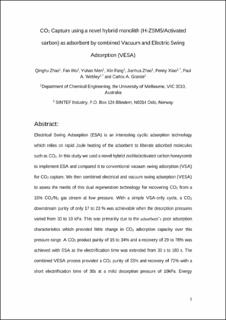| dc.contributor.author | Zhao, Qinghu | |
| dc.contributor.author | Wu, Fan | |
| dc.contributor.author | Men, Yuhan | |
| dc.contributor.author | Fang, Xin | |
| dc.contributor.author | Zhao, Jianhua | |
| dc.contributor.author | Xiao, Penny | |
| dc.contributor.author | Webley, Paul A. | |
| dc.contributor.author | Grande, Carlos Adolfo | |
| dc.date.accessioned | 2020-05-12T07:42:34Z | |
| dc.date.available | 2020-05-12T07:42:34Z | |
| dc.date.created | 2019-06-18T09:45:06Z | |
| dc.date.issued | 2019 | |
| dc.identifier.citation | Chemical Engineering Journal. 2019, 358 707-717. | en_US |
| dc.identifier.issn | 1385-8947 | |
| dc.identifier.uri | https://hdl.handle.net/11250/2653996 | |
| dc.description.abstract | Electrical swing adsorption (ESA) is an interesting cyclic adsorption technology which relies on rapid Joule heating of the adsorbent to liberate adsorbed molecules such as CO2. In this study we used a novel hybrid zeolite/activated carbon honeycomb to implement ESA and compared it to conventional vacuum swing adsorption (VSA) for CO2 capture. We then combined electrical and vacuum swing adsorption (VESA) to assess the merits of this dual regeneration technology for recovering CO2 from a 15% CO2/N2 gas stream at low pressure. With a simple VSA-only cycle, a CO2 downstream purity of only 17–23% was achievable when the desorption pressures varied from 30 to 10 kPa. This was primarily due to the adsorbent’s poor adsorption characteristics which provided little change in CO2 adsorption capacity over this pressure range. A CO2 product purity of 15–34% and a recovery of 29–78% was achieved with ESA as the electrification time was extended from 30 s to 180 s. The combined VESA process provided a CO2 purity of 33% and recovery of 72% with a short electrification time of 30 s at a mild desorption pressure of 10 kPa. Energy calculations indicate that the total specific energy for VESA was lower than ESA alone but still higher than VSA, although the latter suffered from low purity. | en_US |
| dc.language.iso | eng | en_US |
| dc.publisher | Elsevier | en_US |
| dc.rights | Attribution-NonCommercial-NoDerivatives 4.0 Internasjonal | * |
| dc.rights.uri | http://creativecommons.org/licenses/by-nc-nd/4.0/deed.no | * |
| dc.subject | CO2 capture | en_US |
| dc.subject | Adsorption | en_US |
| dc.subject | Monolith | en_US |
| dc.subject | Electrical swing adsorption | en_US |
| dc.subject | Vacuum swing adsorption | en_US |
| dc.title | CO2 capture using a novel hybrid monolith (H-ZSM5/activated carbon) as adsorbent by combined vacuum and electric swing adsorption (VESA) | en_US |
| dc.type | Journal article | en_US |
| dc.type | Peer reviewed | en_US |
| dc.description.version | acceptedVersion | en_US |
| dc.rights.holder | Postprint version of published article, published under a CC-NC-ND license | en_US |
| dc.source.pagenumber | 707-717 | en_US |
| dc.source.volume | 358 | en_US |
| dc.source.journal | Chemical Engineering Journal | en_US |
| dc.identifier.doi | 10.1016/j.cej.2018.09.196 | |
| dc.identifier.cristin | 1705523 | |
| cristin.unitcode | 7401,80,40,0 | |
| cristin.unitname | Prosessteknologi | |
| cristin.ispublished | true | |
| cristin.fulltext | original | |
| cristin.qualitycode | 2 | |

